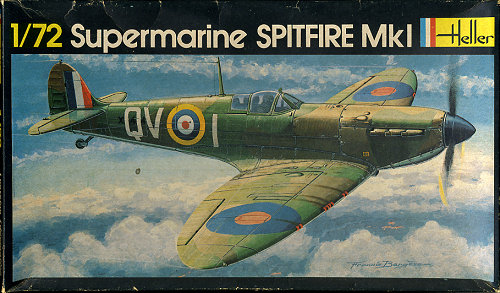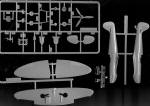
| KIT: | Heller 1/72 Spitfire I |
| KIT #: | 280 |
| PRICE: | $3.50 when new |
| DECALS: | One option |
| REVIEWER: | Scott Van Aken |
| NOTES: |

| HISTORY |
One of the few aircraft to remain in production from the beginning of the war to the end, the Supermarine Spitfire gained popular acclaim during the Battle of Britain as its pilots bravely fought against the Luftwaffe during the Summer of 1940. Ignoring the fact that the Hurricane was the more numerous of the two and that it did most of the bomber interception, the Spitfire is the one that strikes our fancy of 'the few' who fought during those perilous time.
Designed about the same time as it's adversary, the Bf-109, the Spitfire was a much more elegant aircraft; full of curves where the 109 was all angles. This curvaceous design also meant that it was more difficult to construct and repair, but gave it excellent maneuverability compared to the faster 109E.
Like the 109, the Spitfire was designed as a point defense fighter and not a longer range bomber escort. The Spitfire I and II was never fitted with the bulky long range drop tanks as eventually was the 109E since most combat between the two occurred over British territory and bases. Subsequent Spitfire designs changed that and the Spitfires of 1945, while still obviously a Spitfire, had few parts in common with the 1939 versions.
| THE KIT |
 Modeling
goes through phases with some companies taking the limelight while others seem
to fade in regards to producing new kits. Heller is one of those companies. In
the late 1960s and even into the 1980s, Heller constantly had new kits coming
out and each one was eagerly purchased and most of them were built. Yet this did
not continue and once the Japanese companies had assumed ascendancy of the
market, Heller and others seem to have come to a near stop when it came to new
kits.
Modeling
goes through phases with some companies taking the limelight while others seem
to fade in regards to producing new kits. Heller is one of those companies. In
the late 1960s and even into the 1980s, Heller constantly had new kits coming
out and each one was eagerly purchased and most of them were built. Yet this did
not continue and once the Japanese companies had assumed ascendancy of the
market, Heller and others seem to have come to a near stop when it came to new
kits.
This particular kit is one of their earlier productions, despite the box number that might indicate otherwise. Born in an era when detail = rivets, this one is superbly detailed by those standards. Fine raised detail every where you look. Heller even went so far as to note the positions of the roundels on the wings and fuselage with raised lines so one wouldn't get their placement wrong.
In the cockpit are two bulkheads; the forward one has a
somewhat well detailed instrument panel and the rudder pedals molded on. A seat
and a rather odd flat panel that looks like a radio goes on the rear bulkhead.
No floor, no control stick, no pilot. But not a problem as the canopy isn't
exactly ultra-thin and is rather distorted. Oddly, it is in two pieces with the small rear section being separate from the front.
the small rear section being separate from the front.
Flip the aircraft over and one immediately notices that Heller neglected the rather prominent 'gull' where the wing meets the aft fuselage, a common omission on Spit kits of the time. The landing gear and wheels can be best described as 'toy-like' as they have little in common with the actual units, another failing of older Heller kits. Of course, the wheel wells have no detail and are not even boxed in. How far we have come.
Instructions from Heller at the time consisted of an exploded diagram of the parts with a set of build instructions also included in English and German on the back of the sheet. There is a small decal/painting guide with generic color information and markings (by now well past viability) for a single aircraft of some unnamed unit.
| CONCLUSIONS |
OK, so you aren't going to rush out and look for this kit. However, having built one in the distant past, I can tell you that it goes together well and certainly looks the part when one is done. It is a kit that one who collects Spits should have in their collection and it is one that youngsters will enjoy assembling.
May 2007
Thanks to me and the WCM raffle for this one.
If you would like your product reviewed fairly and quickly by a site that has over 350,000 visitors a month, please contact me or see other details in the Note to Contributors.